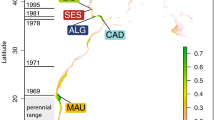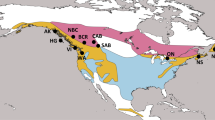Abstract
Because of the high mutation rate of microsatellites, polymorphism at microsatellite loci might be predicted to reflect the effective population size over a time span of about 10,000 years and thus to be associated with biogeographic factors impacting species on that time frame. This prediction was tested by comparing heterozygosity at microsatellite loci from 294 bird species, including 58 species endemic to oceanic islands. Controlling statistically for phylogenetic effects, mean heterozygosity was significantly reduced in oceanic island endemics compared to other species. There was also an effect of current endangerment, statistically independent of the effect of island endemicity. These results support the hypothesis that long-term effective population size can be an important causative factor behind differences among species with respect to microsatellite heterozygosity.


Similar content being viewed by others
References
Boersma PB (1998) Population trends of the Galápagos Penguin: impacts of El Niño and La Niña. Condor 100:245–253
Brinkmann B, Klintschar M, Neuhuber F, Hühne J, Rolf B (1998) Mutation rate in human microsatellites: influence of the structure and length of the tandem repeat. Am J Hum Genet 62:1408–1415
Ellegren H (2004) Microsatellites: simple sequences with complex evolution. Nat Rev Genet 5:435–445
Evans SR, Sheldon BC (2008) Interspecific patterns of genetic diversity in birds: correlations with extinction risk. Conserv Biol 22:1016–1025
Fa JE, Purvis A (1997) Body size, diet and population density in Afro tropical forest mammals: a comparison with neotropical species. J Anim Ecol 66:98–112
Fisher DO, Owens IP (2004) The comparative method in conservation biology. Trends Ecol Evol 19:391–398
Grafen A (1989) The phylogenetic regression. Phil Trans R Soc Lond B 326:119–157
Holt AR, Gaston KJ, He F (2002) Occupancy-abundance relationships and spatial distribution: a review. Basic Appl Ecol 3:1–13
Hughes AL (1999) Differential human impact on the survival of genetically distinct avian lineages. Bird Conserv Int 9:147–154
Hughes AL (2004) A statistical analysis of factors associated with historical extinction and current endangerment of non-passerine birds. Wilson Bull 116:330–336
Hughes AL, Hughes MA (2007) Coding sequence polymorphism in avian mitochondrial genomes reflects population histories. Mol Ecol 16:1369–1376
Kohn MH, Murphy WJ, Ostrander EA, Wayne RK (2006) Genomics and conservation genetics. Trends Ecol Evol 21:629–637
Lande R (1998) Risk of population extinction from fixation of deleterious and reverse mutations. Genetica 102/103:21–27
Livezey BC, Zusi RL (2007) Higher-order phylogeny of modern birds (Teropoda, Aves: Neornithes) based on comparative anatomy. II. Analysis and discussion. Zool J Linn Soc 149:1–95
Lynch M (2007) The origins of genome architecture. Sinauer, Sunderland
Maguire GS, Mulder RA (2004) Breeding biology and demography of the southern emu-wren (Stipiturus malachurus). Aust J Zool 52:583–604
Nabholz B, Glémin S, Galtier N (2009) The erratic mitochondrial clock: variations of mutation rate, not population size, affect mtDNA diversity across birds and mammals. BMC Evol Biol 9:54
Nei M (1987) Molecular evolutionary genetics. Columbia University Press, New York
Nei M, Graur D (1984) Extent of protein polymorphism and the neutral mutation theory. Evol Biol 17:73–118
Nei M, Maruyama T, Chakaborty R (1975) The bottleneck effect and genetic variability in populations. Evolution 29:1–10
Pearce JM, Talbot SL, Pierson BJ, Petersen MR, Scribner KT, Dickson DL, Mosbacj A (2004) Lack of spatial genetic structure among nesting and wintering King Eiders. Condor 106:229–240
Primmer CR, Painter JN, Koskinen MT, Palo J, Merilä J, Piironen J (2005) Factors affecting avian cross-species microsatellite amplification. J Avian Biol 36:348–360
Purvis A, Gittlemann JL, Cowlishaw G, Mace GM (2000) Predicting extinction risk in declining species. Proc R Soc Lond B 267:1947–1952
Rubenstein DR (2005) Isolation and characterization of polymorphic microsatellite loci in the plural cooperatively breeding superb starling, Lamprotornis superbus. Mol Ecol Notes 5:739–744
Schlötterer C (2000) Evolutionary dynamics of microsatellite DNA. Chromosoma 109:365–371
Trainer JM, McDonald DB (1995) Singing performance, frequency matching and courtship success of long-tailed mamakins (Chiroxiphia linearis). Behav Ecol Sociobiol 37:249–254
Wingfield JC, Ishii S, Kikuchi M, Wakabayashi S, Sakai H, Yamaguchi N, Wada M, Chikatsuji K (2000) Biology of a critically endangered species, the Toki (Japanese Crested Ibis) Nipponia nippon. Ibis 142:1–11
Acknowledgments
This research was supported by grant GM43940 from the National Institutes of Health.
Author information
Authors and Affiliations
Corresponding author
Electronic supplementary material
Below is the link to the electronic supplementary material.
Rights and permissions
About this article
Cite this article
Hughes, A.L. Reduced microsatellite heterozygosity in island endemics supports the role of long-term effective population size in avian microsatellite diversity. Genetica 138, 1271–1276 (2010). https://doi.org/10.1007/s10709-010-9527-z
Received:
Accepted:
Published:
Issue Date:
DOI: https://doi.org/10.1007/s10709-010-9527-z




